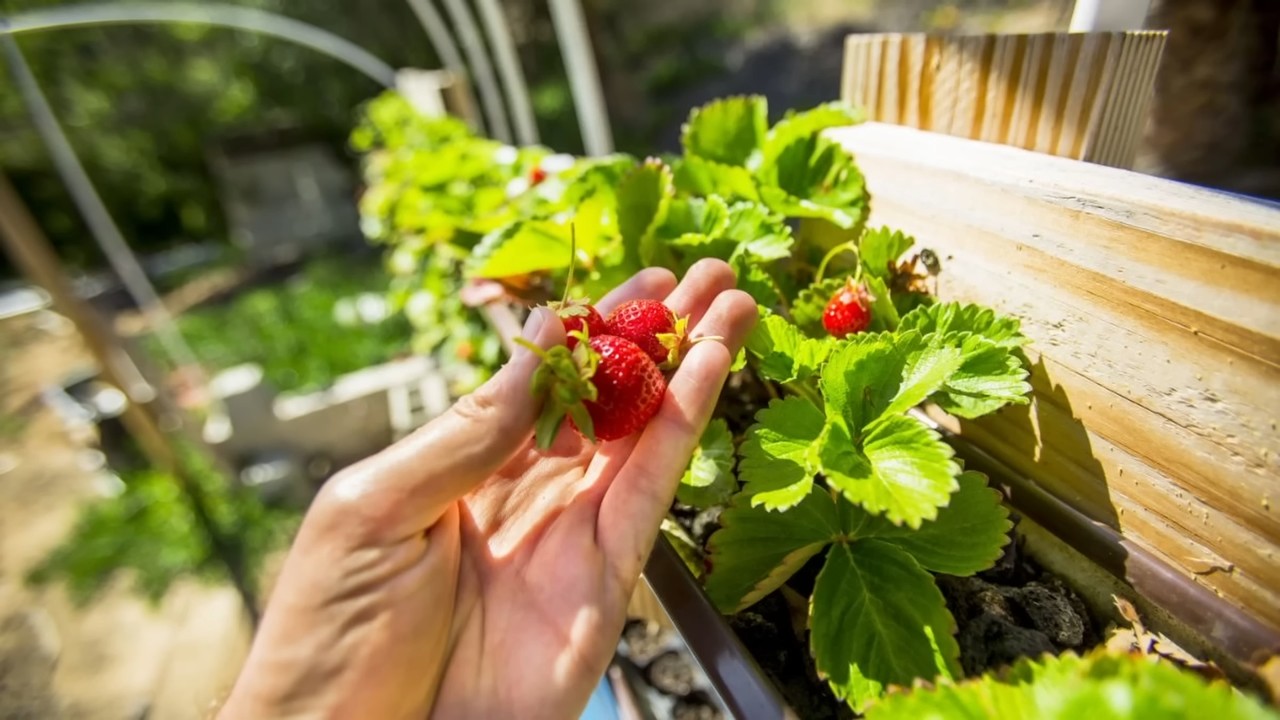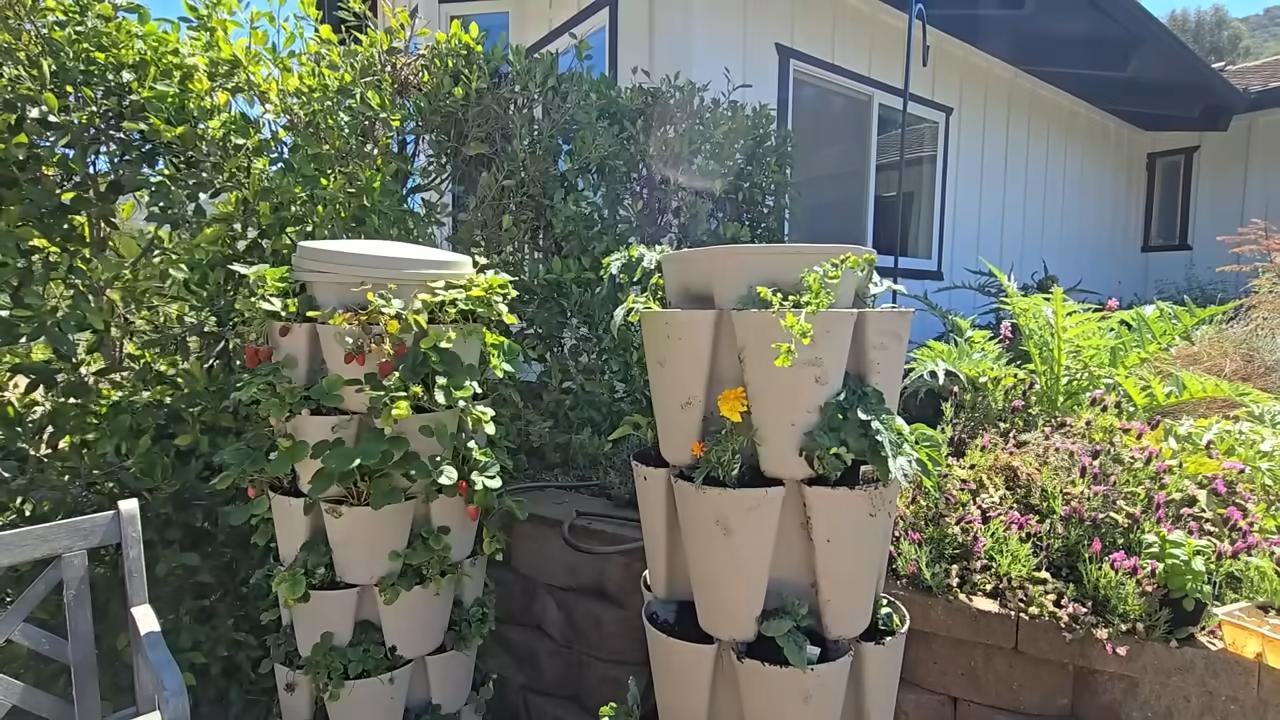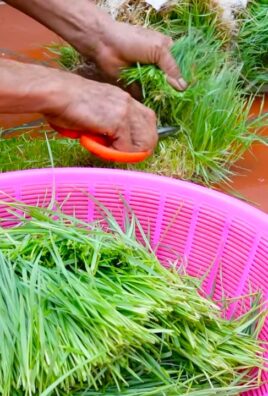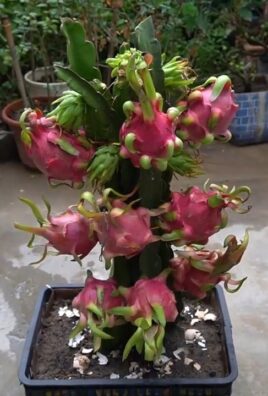Grow Strawberries like a pro, even if you think you have a black thumb! Have you ever dreamed of plucking juicy, sun-ripened strawberries straight from your own garden? Imagine the sweet taste, the vibrant color, and the satisfaction of knowing you grew them yourself. Well, stop dreaming and start doing! This article is packed with simple, yet effective DIY tricks and hacks to help you grow strawberries successfully, whether you’re working with raised beds or containers.
Strawberries have a rich history, enjoyed for centuries and even revered in ancient Roman culture for their medicinal properties. Today, they’re a beloved fruit worldwide, but store-bought berries often lack the intense flavor of homegrown ones. That’s where we come in!
Let’s face it, gardening can sometimes feel overwhelming. Maybe you’ve tried growing strawberries before and faced challenges like pests, diseases, or simply not enough space. That’s why I’m sharing these easy-to-follow DIY solutions. We’ll cover everything from choosing the right strawberry varieties for your climate to building your own raised bed or optimizing container drainage. With these tricks up your sleeve, you’ll be harvesting delicious strawberries in no time, impressing your friends and family with your newfound gardening skills. Get ready to transform your outdoor space into a strawberry paradise!

Growing Strawberries: From Raised Beds to Containers – A DIY Guide
Hey there, fellow gardening enthusiasts! I’m so excited to share my tried-and-true methods for growing delicious, juicy strawberries right in your backyard (or even on your balcony!). Whether you’re dreaming of a sprawling raised bed overflowing with berries or prefer the convenience of container gardening, I’ve got you covered. Let’s dive into the wonderful world of strawberry cultivation!
Choosing Your Strawberry Variety
Before we get our hands dirty, let’s talk about strawberry varieties. This is crucial because different types thrive in different climates and have varying fruiting habits.
* June-Bearing: These are your classic strawberries, producing one large crop in the spring (usually around June, hence the name!). They’re perfect if you want a big batch for jam-making or freezing.
* Everbearing: Don’t let the name fool you; everbearing strawberries don’t produce fruit continuously. Instead, they offer two or three harvests throughout the growing season – spring, summer, and fall. They’re great for a steady supply of berries.
* Day-Neutral: These are the most consistent producers, fruiting throughout the growing season as long as temperatures are moderate. They’re less sensitive to day length than other varieties.
My Recommendation: For beginners, I often suggest starting with everbearing or day-neutral varieties. They’re more forgiving and provide a longer harvest period. Do some research on what grows best in your specific climate!
Preparing Your Growing Space
Now, let’s get our hands dirty! Whether you’re opting for a raised bed or containers, proper preparation is key.
Raised Bed Preparation
Raised beds offer excellent drainage and allow you to control the soil quality. Here’s how I set mine up:
* Location, Location, Location: Strawberries need at least 6-8 hours of sunlight per day. Choose a sunny spot in your yard.
* Building the Bed: You can build a raised bed from wood, concrete blocks, or even repurposed materials. Aim for a depth of at least 12 inches. I personally prefer cedar wood because it’s naturally rot-resistant.
* Soil Preparation: This is where the magic happens! Strawberries thrive in well-draining, slightly acidic soil (pH 5.5-6.5). I create a mix of:
* 1/3 Compost: Adds nutrients and improves drainage.
* 1/3 Topsoil: Provides structure and support.
* 1/3 Peat Moss or Coco Coir: Helps retain moisture and acidify the soil.
* Testing the Soil: I highly recommend using a soil testing kit to check the pH level. You can adjust it by adding lime to raise the pH or sulfur to lower it.
* Adding Fertilizer: Incorporate a slow-release fertilizer specifically formulated for berries. Follow the instructions on the package.
Container Preparation
Container gardening is perfect for small spaces or if you want to move your strawberries around.
* Choosing the Right Container: Select a container that’s at least 12 inches in diameter and 8 inches deep. Make sure it has drainage holes!
* Potting Mix: Use a high-quality potting mix specifically designed for containers. Avoid using garden soil, as it can compact and hinder drainage.
* Drainage: Place a layer of gravel or broken pottery at the bottom of the container to improve drainage.
* Location: Just like with raised beds, ensure your containers receive at least 6-8 hours of sunlight per day.
Planting Your Strawberry Plants
Alright, the moment we’ve been waiting for – planting those strawberry babies!
Step-by-Step Planting Guide:
1. Soaking the Roots: Before planting, soak the roots of your strawberry plants in water for about 30 minutes. This helps rehydrate them.
2. Digging the Hole: Dig a hole that’s large enough to accommodate the root ball.
3. Planting Depth: This is crucial! The crown of the plant (the point where the roots meet the stem) should be level with the soil surface. Planting too deep can cause the crown to rot, while planting too shallow can dry out the roots.
4. Spacing: Space June-bearing strawberries about 18 inches apart in rows that are 3-4 feet apart. Everbearing and day-neutral varieties can be planted closer together, about 12 inches apart. In containers, I usually plant one strawberry plant per 12-inch pot.
5. Backfilling: Gently backfill the hole with soil, making sure to avoid burying the crown.
6. Watering: Water thoroughly after planting.
7. Mulching: Apply a layer of mulch around the plants to help retain moisture, suppress weeds, and keep the berries clean. I like to use straw (hence the name “strawberries”!), but you can also use wood chips or pine needles.
Caring for Your Strawberry Plants
Now that your strawberries are planted, it’s time to provide them with the TLC they need to thrive.
* Watering: Strawberries need consistent moisture, especially during fruiting. Water deeply whenever the top inch of soil feels dry. Avoid overhead watering, as this can promote fungal diseases. Drip irrigation is ideal.
* Fertilizing: Fertilize your strawberries every 4-6 weeks with a balanced fertilizer. Follow the instructions on the package.
* Weeding: Keep your strawberry patch free of weeds, as they can compete for nutrients and water.
* Pest Control: Keep an eye out for common strawberry pests like slugs, snails, and aphids. Hand-picking them off the plants is often effective. You can also use organic pest control methods like diatomaceous earth or insecticidal soap.
* Disease Prevention: Strawberries are susceptible to fungal diseases like gray mold and leaf spot. To prevent these diseases, ensure good air circulation, avoid overhead watering, and remove any infected leaves promptly.
* Renovating June-Bearing Strawberries: After the harvest, June-bearing strawberries need to be renovated. This involves mowing the foliage down to about 1 inch above the crown and thinning out the plants. This helps promote new growth and a better harvest the following year.
* Removing Runners: Strawberry plants produce runners, which are horizontal stems that grow along the ground and develop new plantlets. If you want to maximize fruit production, remove the runners regularly. However, if you want to propagate new plants, you can allow the runners to root.
Harvesting Your Strawberries
The moment of truth! Harvesting your own strawberries is one of the most rewarding experiences in gardening.
* When to Harvest: Strawberries are ready to harvest when they are fully red, plump, and slightly soft to the touch.
* How to Harvest: Gently twist or cut the stem just above the berry. Avoid pulling the berry, as this can damage the plant.
* Harvesting Time: Harvest your strawberries in the morning, after the dew has dried.
* Storage: Freshly harvested strawberries are best eaten right away. However, you can store them in the refrigerator for a few days. Don’t wash them until you’re ready to eat them, as this can promote mold growth.
Troubleshooting Common Strawberry Problems
Even with the best care, you might encounter some challenges along the way. Here are a few common problems and how to address them:
* Small Berries: This can be caused by insufficient sunlight, poor soil, or overcrowding. Make sure your plants are getting enough sun, amend the soil with compost, and thin out the plants if necessary.
* Lack of Fruit: This can be due to poor pollination, frost damage, or nutrient deficiencies. Ensure your plants are getting enough water and fertilizer, and protect them from frost.
* Pest Infestations: As mentioned earlier, keep an eye out for common strawberry pests and take action promptly.
* Fungal Diseases: Prevent fungal diseases by ensuring good air circulation, avoiding overhead watering, and removing any infected leaves.
Extending the Strawberry Season
Want to enjoy strawberries for even longer? Here are a few tips:
* Succession Planting: Plant different varieties of strawberries that ripen at different times.
* Row Covers: Use row covers to protect your plants from frost and extend the growing season.
* Cold Frames: Cold frames can provide extra protection during the winter months.
Propagating Strawberries
Once you’ve got the hang of growing strawberries, you can easily propagate new plants from runners. Simply allow the runners to root in small pots filled with potting mix. Once the plantlets have developed a strong root system, you can transplant them to their permanent location.
Enjoying Your Harvest
Now for the best part – enjoying the fruits (or rather, berries!) of your labor! Freshly picked strawberries are delicious on their own, but they’re also fantastic in pies, jams, smoothies, and

Conclusion
So, there you have it! Growing strawberries in raised beds or containers isn’t just a gardening trend; it’s a game-changer for anyone who loves fresh, juicy berries. We’ve explored the ins and outs of creating the perfect environment for your strawberry plants, from choosing the right container size and soil mix to optimizing sunlight and watering schedules. The benefits are undeniable: improved drainage, better pest control, and the sheer joy of harvesting your own homegrown goodness right outside your door.
But why is this DIY approach a must-try? Simply put, it puts you in control. You dictate the quality of the soil, ensuring it’s free from harmful chemicals and perfectly tailored to your strawberry plants’ needs. You manage the watering, preventing overwatering and root rot, common problems in traditional garden beds. And you can easily move your containers to chase the sun or shelter them from harsh weather. Plus, let’s be honest, a vibrant strawberry patch in a raised bed or overflowing from a container is a beautiful addition to any home.
Don’t be afraid to experiment! Try different strawberry varieties to find your favorites. Everbearing strawberries will provide fruit throughout the growing season, while June-bearing varieties offer a concentrated harvest. Consider companion planting with herbs like basil or thyme to deter pests and enhance flavor. You can even get creative with your container choices, using repurposed items like old tires or wooden crates for a rustic touch.
Growing strawberries in raised beds or containers is an incredibly rewarding experience. It’s a chance to connect with nature, learn new skills, and enjoy the fruits (literally!) of your labor. It’s also a fantastic way to involve children in gardening, teaching them about where their food comes from.
We’re confident that with the information we’ve shared, you’re well-equipped to embark on your own strawberry-growing adventure. Don’t hesitate to adapt these techniques to suit your specific climate and growing conditions. Remember, gardening is a journey of learning and discovery.
Now, it’s your turn! We encourage you to give this DIY trick a try. Start small, perhaps with just a few containers, and gradually expand as you gain confidence. And most importantly, share your experience with us! We’d love to hear about your successes, challenges, and any tips you’ve discovered along the way. Post photos of your strawberry plants, share your favorite recipes using your homegrown berries, and let’s create a community of passionate strawberry growers. Happy gardening!
Frequently Asked Questions (FAQ)
What is the best type of container for growing strawberries?
The best type of container for growing strawberries depends on your space and aesthetic preferences. However, there are a few key considerations. First, ensure the container has adequate drainage holes to prevent waterlogging. Strawberries prefer well-draining soil, and excess moisture can lead to root rot. Second, consider the size of the container. A container that is at least 12 inches in diameter and 8 inches deep is generally recommended for a single strawberry plant. Larger containers, such as raised beds, can accommodate multiple plants and provide more room for root growth.
Terracotta pots, plastic containers, and even repurposed items like old tires or wooden crates can be used. Terracotta pots are porous, which helps with drainage, but they can also dry out quickly in hot weather. Plastic containers retain moisture better but may require more careful watering. Raised beds offer excellent drainage and allow for easy access to your plants. Ultimately, the best container is one that meets your needs and provides a healthy environment for your strawberry plants to thrive.
What type of soil is best for growing strawberries in containers?
Strawberries thrive in well-draining, slightly acidic soil with a pH between 5.5 and 6.5. A good potting mix specifically formulated for fruits and vegetables is an excellent choice. You can also create your own mix by combining equal parts of potting soil, compost, and perlite or vermiculite. The potting soil provides essential nutrients, the compost adds organic matter and improves drainage, and the perlite or vermiculite enhances aeration and prevents compaction.
Avoid using garden soil in containers, as it tends to be too heavy and doesn’t drain well. This can lead to root rot and other problems. When preparing your soil mix, ensure it’s loose and airy to allow for proper root development. You can also add a slow-release fertilizer to provide a steady supply of nutrients throughout the growing season.
How often should I water my strawberry plants in containers?
Watering frequency depends on several factors, including the weather, the type of container, and the stage of growth. Generally, strawberry plants in containers need to be watered more frequently than those in the ground, as containers tend to dry out faster. Check the soil moisture regularly by sticking your finger about an inch into the soil. If it feels dry, it’s time to water.
Water deeply until water drains out of the bottom of the container. Avoid overhead watering, as this can promote fungal diseases. Instead, water at the base of the plant. During hot, dry weather, you may need to water daily or even twice a day. During cooler, wetter weather, you may only need to water every few days. Pay close attention to your plants and adjust your watering schedule accordingly.
How much sunlight do strawberry plants need?
Strawberry plants need at least 6-8 hours of direct sunlight per day to produce abundant fruit. Choose a location for your containers that receives plenty of sunlight throughout the day. If you live in a hot climate, some afternoon shade may be beneficial to prevent the plants from overheating.
If you’re growing strawberries indoors, you’ll need to supplement with artificial light. Grow lights specifically designed for plants are a good option. Position the lights about 6-12 inches above the plants and keep them on for 12-16 hours per day.
How do I protect my strawberry plants from pests and diseases?
Several pests and diseases can affect strawberry plants, including aphids, spider mites, slugs, snails, and fungal diseases like powdery mildew and gray mold. Regular inspection of your plants is crucial for early detection and treatment.
To prevent pests, consider using organic pest control methods such as insecticidal soap or neem oil. You can also introduce beneficial insects like ladybugs, which prey on aphids. To protect against slugs and snails, use beer traps or copper tape around your containers.
To prevent fungal diseases, ensure good air circulation around your plants and avoid overhead watering. Remove any dead or diseased leaves promptly. You can also use a fungicide specifically formulated for strawberries.
When is the best time to plant strawberries in containers?
The best time to plant strawberries in containers depends on your climate and the type of strawberry you’re growing. In general, spring or fall are the ideal times to plant. Spring planting allows the plants to establish themselves before the hot summer months, while fall planting allows them to develop a strong root system before winter.
If you live in a cold climate, it’s best to plant in the spring after the last frost. If you live in a mild climate, you can plant in the fall or winter. When planting, choose healthy, disease-free plants from a reputable nursery.
How do I overwinter my strawberry plants in containers?
If you live in a cold climate, you’ll need to protect your strawberry plants from freezing temperatures during the winter. One option is to move the containers to a sheltered location, such as a garage or shed. Water the plants sparingly during the winter, just enough to keep the soil from drying out completely.
Another option is to insulate the containers by wrapping them in burlap or bubble wrap. You can also mulch around the plants with straw or leaves to provide additional insulation. In the spring, gradually acclimate the plants to outdoor conditions before moving them back to their sunny location.
Can I grow strawberries indoors year-round?
Yes, you can grow strawberries indoors year-round with the right conditions. You’ll need to provide adequate light, either through a sunny window or with grow lights. You’ll also need to maintain a consistent temperature and humidity level.
Choose a self-pollinating strawberry variety, such as ‘Everbearing’ or ‘Day-Neutral,’ as you won’t have the benefit of natural pollinators indoors. Hand-pollinate the flowers by gently brushing them with a small paintbrush. With proper care, you can enjoy fresh strawberries even in the middle of winter.




Leave a Comment